
Lion with a snare around its neck. Photo by: Frederike Otten. Courtesy of Panthera.
Bushmeat hunting has become a grave concern for species in West and Central Africa, but a new report notes that lesser-known illegal hunting in Africa’s iconic savannas is also decimating some animals. Surprisingly, illegal hunting across eastern and southern Africa is hitting big predators particularly hard, such as cheetah, lion, leopard, and wild dog. Although rarely targets of hunters, these predators are running out of food due to overhunting and, in addition, often becoming victims of snares set out for other species.
“Snaring is the most common illegal hunting method and is particularly undesirable from a conservation perspective as it is highly effective, difficult to control, unselective in terms of the genders or species of animals captured, wasteful, and has severe animal welfare implications,” reads the report which was co-authored by Panthera, the Zoological Society of London (ZSL), and the Wildlife Conservation Society (WCS).
The report finds that demand for bushmeat is growing in both eastern and southern Africa as populations boom–human populations in Africa are growing faster than anywhere else in the world–and protected areas suffer from ongoing human encroachment. In addition, bushmeat is becoming seen as a “luxury” good in urban centers, pushing some in rural communities to see illegal hunting as a new livelihood where there are few.
 Snared wild dog. Photo by: Frederike Otten. Courtesy of Panthera. |
The bushmeat boom, which has not been largely studied across eastern and southern Africa, has put the continents big predators on notice, according to the report.
“Most cheetahs and African wild dogs occur outside protected areas, coexisting with people and their livestock, and are very vulnerable to snaring and the loss of their wild prey,” says Netty Purchase with both ZSL and WCS.
Cheetahs (Acinonyx jubatus) are currently listed as Vulnerable by the IUCN Red List, while African wild dogs (Lycaon pictus) are considered Endangered. Africa’s most well-known top predator, the lion (Panthera leo), is listed as Vulnerable with data showing it has plunged by 30 percent since 1990. Leopards (Panthera pardus) are probably doing the best of the four, and are listed as Near Threatened. All of these predators face other threats beyond illegal hunting—including habitat loss, human-wildlife conflict, and in some cases trophy hunting—but an overall decline in prey and injuries or death caused by snare cannot be overstated. For example, in Mozambique’s Niassa Reserve over half of lion mortalities are caused by snares.
The report notes that some areas have undergone “empty savanna syndrome,” similar to the more well-known “empty forest syndrome.” The ecosystem is there, but large wild mammals are simply gone due to unregulated over-hunting. In some countries, hunters have begun turning to smaller animals, as larger-bodied mammals have vanished.
Recommendations from the report include addressing human population growth through education and family planning; better land-use planning; providing alternative livelihoods and other protein sources in rural areas; encouraging tourism and sustainable-use of wildlife; as well as passing and enforcing better laws.
“Frank discussion of the issue of high levels of human population growth within and near to protected areas is required,” the freely-available report reads, “because if current trends continue, other interventions to address illegal hunting the bushmeat trade are much less likely to succeed.”

Snared cheetah recovered by a park ranger in Zambia. Photo by: Zambia Carnivore Programme.
Related articles
New campaign targets snares in effort to save world’s big cats
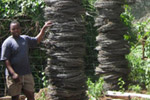
(06/05/2012) Last summer, a wild Sumatran tiger—one of only a few hundred surviving on the island—made news in a story that did not have a happy ending. The cat had become entangled in a snare in a logging concession owned by Asia Pulp and Paper (APP). The tiger spent seven days without food or water before wildlife rangers found it, but its snared right paw was a bloody black mess. Although the rangers were able to sedate and free the cat, it died shortly thereafter from its wounds.
Authorities confiscate 600 dead elephants’ worth of ivory in Hong Kong
(10/22/2012) Hong Kong authorities have confiscated two massive shipments of elephant tusks, totaling 1,209 tusks, stemming from Kenya and Tanzania. Representing over 600 poached elephants, the shipments are estimated to be worth $3.4 million on the black market. African elephants are being decimated for their tusks in recent years with heavily-armed and well-connected poachers—backed by criminal syndicates—killing off whole herds in some cases.
South Africa hits another new record in rhino killings
(10/18/2012) Four hundred and fifty-five rhinos have been killed by poachers in South Africa since the beginning of the year. The number surpasses the record set last year (448) and proves that national efforts to stem poaching have not yet made a dent in actual killings. The mass killing has been spurred on by high demand for powdered rhino horn in Vietnam and China. A traditional curative in Asia, rhino horn has no medicinal properties according to scientists.
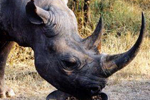
(10/15/2012) 23,680 = the estimated number of wild rhinoceroses in South Africa. 35,000,000 = the number of American dollars generated by rhino hunting in South Africa. 97% = the percentage increase in illegally-hunted rhinos in 2011 from the national average in 1990. 30,000 = the number of pounds of rhino horns confiscated from poachers since 2010. 65 = the number of horns that have been stolen in South Africa from public display. 430…the number of rhinos killed this year, and counting…
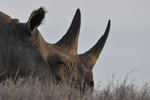
(10/02/2012) So far this year, South Africa has lost 430 rhinos to poachers, more than one animal a day. The epidemic of rhino poaching, fueled by demand for black-market powdered rhino horn in Vietnam and China, is decimating rhino species worldwide. In fact, last year saw the official extinction of two rhino subspecies: the Vietnamese rhino (Rhinoceros sondaicus annamiticus), a subspecies of the Javan, and the western black rhino (Diceros bicornis longipes), a subspecies of the black. However there is one place where rhinos still thrive. The Lewa Wildlife Conservancy in Kenya has found itself with a unique, but happy, problem: they have so many black rhinos, which are considered Critically Endangered by the IUNC Red List, that they need to move some to stop rhino-fights. In other words, their rhino population has hit its limit for the 25,000 hectare (62,000 acre) nonprofit protected area.
Conflict and perseverance: rehabilitating a forgotten park in the Congo
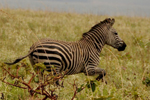
(09/19/2012) Zebra racing across the yellow-green savannah is an iconic image for Africa, but imagine you’re seeing this not in Kenya or South Africa, but in the Democratic Republic of Congo (DRC). Welcome to Upemba National Park: once a jewel in the African wildlife crown, this protected area has been decimated by civil war. Now, a new bold initiative by the Frankfurt Zoological Society (FZS), dubbed Forgotten Parks, is working to rehabilitate Upemba after not only decades of conflict but also poaching, neglect, and severe poverty.
Bushmeat consumption differs between communities in Tanzania
(09/17/2012) Bushmeat consumption depends on the make-up of individual communities, according to a new study in the open access journal Tropical Conservation Science. By interviewing indigenous groups and refugees living near two protected areas in western Tanzania, researchers found that consumption rates differed significantly, likely based on costliness and access.
Turning gorilla poachers into conservationists in the Congo [warning: graphic photos]
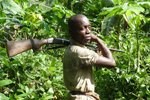
(08/13/2012) Although founded only four years ago, Endangered Species International-Congo, has ambitious plans to protect dwindling Western gorilla populations and aid local people in the Republic of the Congo. The organization, an offshoot of Endangered Species International (ESI), has been spending the last few years studying the bushmeat trade in Pointe-Noire, the country’s second largest city, and developing plans for turning hunters into conservationists.
Poaching in the Serengeti linked to poverty, high legal hunting prices
(07/09/2012) In the effort to protect the Serengeti—arguably Africa’s most famous ecosystem—one of the major problems is the bushmeat trade. Population growth, little available protein, poverty, and a long-standing history of hunting has led many communities to poach wildlife within Serengeti National Park. Interviewing over a thousand community members in the western Serengeti, scientists found that community members are largely aware that wildlife hunting is illegal and that conservation of wild species is important, but hunt animals anyway partly out of necessity.